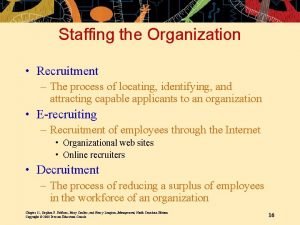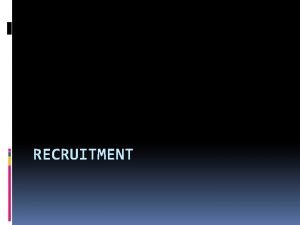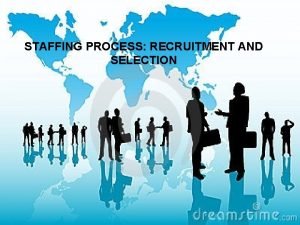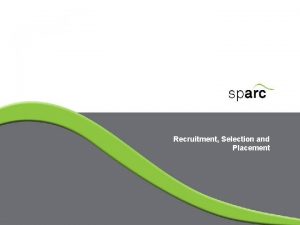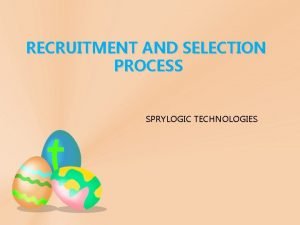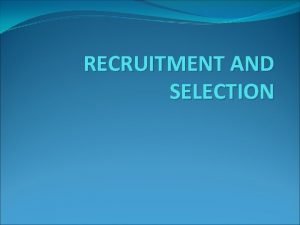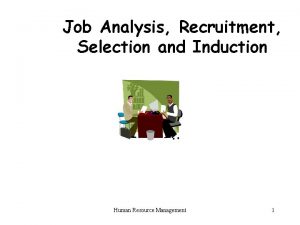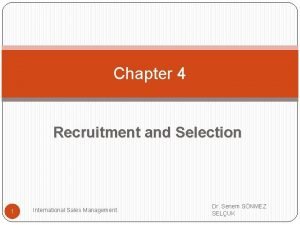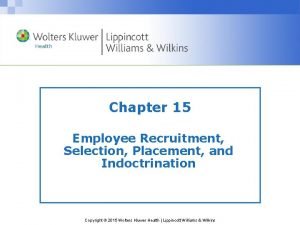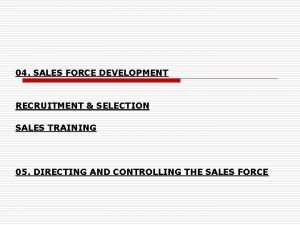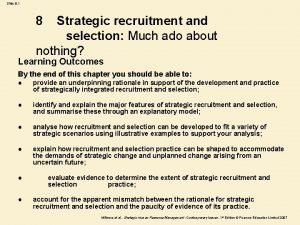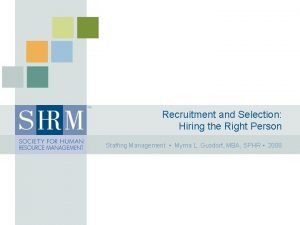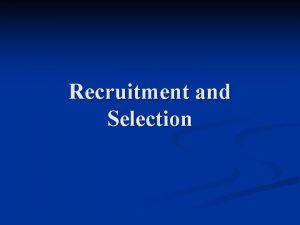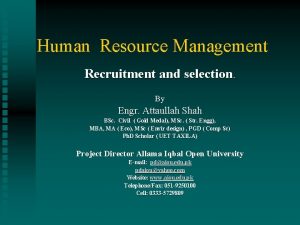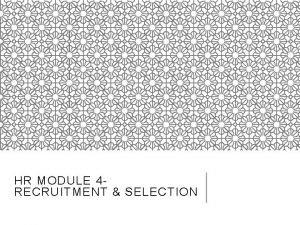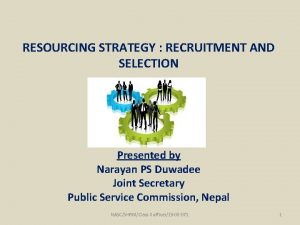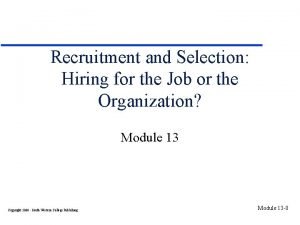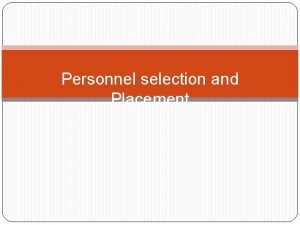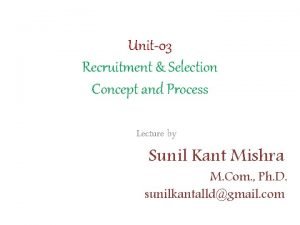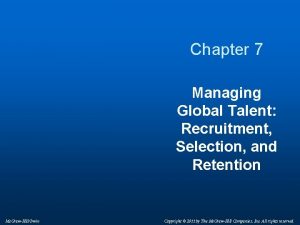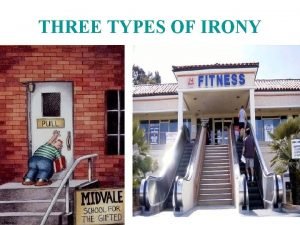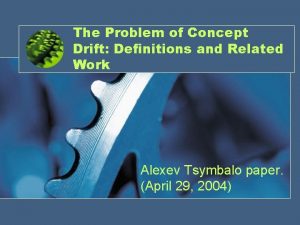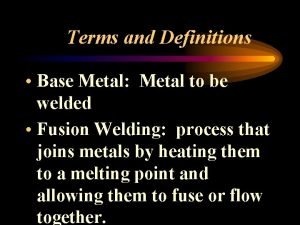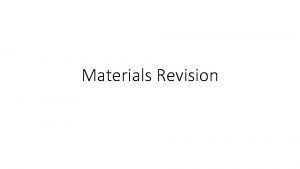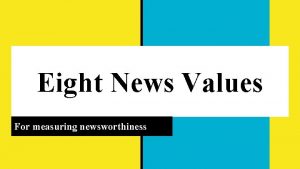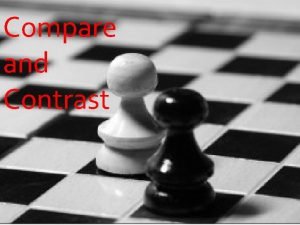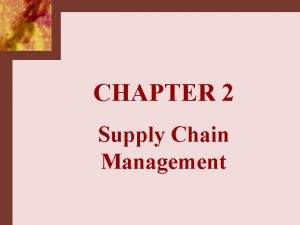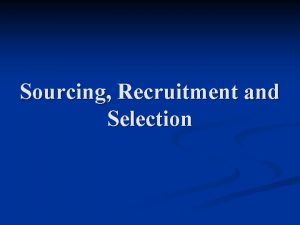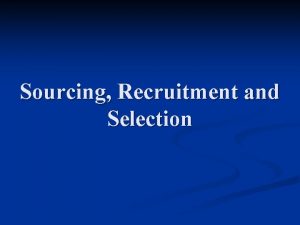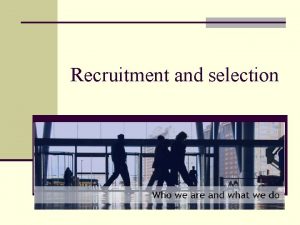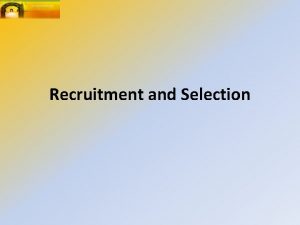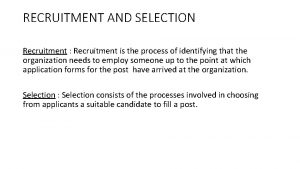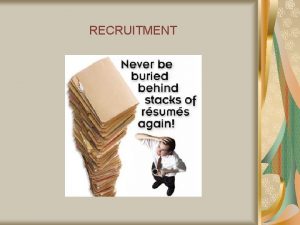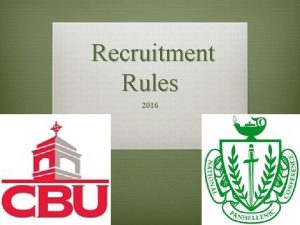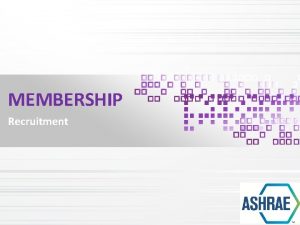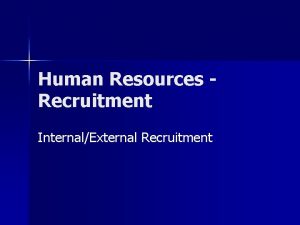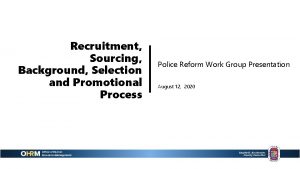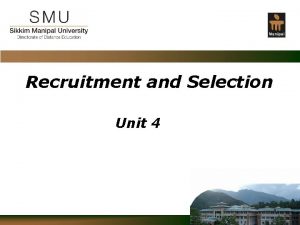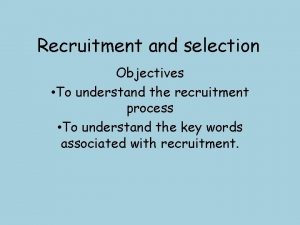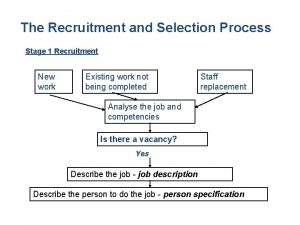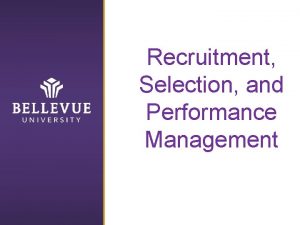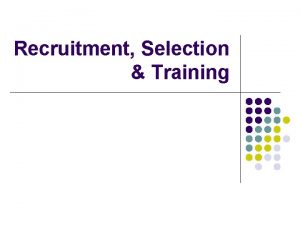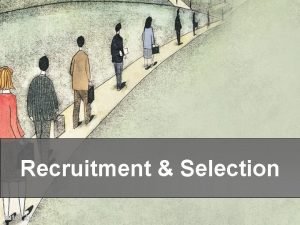Sourcing Recruitment and Selection Definitions Sourcing identifying and
















































- Slides: 48

Sourcing, Recruitment and Selection

Definitions Sourcing identifying and locating high potential recruits. Involves the analysis of different possible sources of recruits to identify those best able to meet the firm’s staffing goals. Recruitment is the process of generating a pool of capable people to apply for employment to an organization. Selection is the process by which managers and others use specific instruments to choose from a pool of applicants a person or persons most likely to succeed in the job(s), given management goals and

The overall aim of the recruitment & selection process… …is to satisfy the human resource needs of the company, … n …with the required number and … n …quality of employees, … n …at minimum costs. n

Stages of recruitment & selection Defining requirements n Defining source: n internal or external n KSAO and/or geographical area n Attracting candidates (recruitment) n Selecting candidates n

Defining requirements n Framework: Business strategy n Human resource plan n Recruitment programme n n Content: Job description (role profile): n Job (person) specification: the minimum requirements n Terms & conditions of employment n

Role profile overall purpose, n relations, n key result areas, n required competencies, n terms and conditions (pay, hours), n special requirements, n development and n career opportunities n

Job specification n n n n Technical competencies Behavioural and attitudinal requirements Qualifications and training (Work) experience Specific demands Organizational fit: corporate culture Special requirements (to accomplish specific tasks) Meeting candidate expectations: ability of the firm to motivate the employee (and make it satisfied) What is the optimal level of the requirements?

Two example for classificational schemes n The seven point plan n n Longer pedigree The fivefold grading system Simpler n More emphasis on dynamic aspects of career n n Competency-based approach n It is person-based rather than job-based

The seven point plan n n n Physical make-up: health, physique, appearance, bearing, speech Attainments: education, qualifications, experience General intelligence Special aptitudes: e. g. manual dexterity, use of words Interests Disposition: acceptability, influence over others, self reliance, steadiness, dependability Circumstances: domestic , economic circumstances

The fivefold grading system Impact on others: health, physique, appearance, bearing, speech n Acquired qualifications: education, qualifications, experience Attainments n Innate abilities: quickness of Intelligence, comprehension and aptitude for learning n Motivation n Adjustment: emotional stability, ability to Disposition stand up to stress, emotional intelligence n

Competency-based approach Analysis of people and what attributes account for their effective and superior performance n Helps to identify the selection techniques (assessment centre, targeted behavioural event interview) n The competencies used should: n n Focus on areas in which candidates will have demonstrated their competency in their working and academic life

n Advantages and disadvantages of Internal Recruitment Advantages of Internal Recruitment: n n n n Builds employee morale Can be initiated very quickly Improves the probability of making a good selection Less costly than initiating external or outsourced searches Results in reduced training time and less training costs Encourages talented individuals to stay with the organization (career) Disadvantages of Internal Recruitment: n n n Inbreeding and lack of new ideas Resentment among employees Increased recruitment and training efforts will result when a position is filled internally because the position vacated by the promoted employee must also be filled with a new staff member (succession management)

Core vs. Contingency personnel n Core personnel n n Employees hired in the “traditional” manner Considered permanent employees Included in the organization’s payroll Contingency personnel n n n Temporary workers Individual contractors „Loaned” personnel n n n Employed by a supplier agency, and are “loaned” to the organization Not included in the organization’s payroll Workers’ salaries and benefits are paid by the supplier

Contingency personnel Advantages Disadvantages Flexibility in type and amount Loyalty to employer or of labor resources company Save costs in benefits and tax Disturbs organizations core morale and culture Immediate access to expertise not present internally Training costs Savings in long-term compensation costs

Attracting candidates (recruitment) Analysis of recruitment strength and weaknesses n Analysis of possible sources of candidates n Advertising (HR marketing) n Attract attention n Create and maintain interests n Stimulate action (!) n

Advertising jobs n Internal sources: n n n Job Postings Data Banks/Skill Inventories/Replacement Charts Supervisor Recommendations Not the same as nepotism: (favoritism in employment based upon kinship) or Intranet External sources: n Applicant Initiated (no advertisement) n n n Walk-Ins, Unsolicited Resumes Employee referral: A recommendation about a potential applicant that is provided by a current employee. Educational institutions, training establishments: it is usually seasonal E-recruitment: cost is about 5% of traditional advertising n n other type of ‘push’. The firm’s public internet site, Job sites, Agency sites, Media sites Job fairs Newspapers, trade journals (in some cases: radio and tv

Make or buy (outsourcing recruitment) n Recruitment consultants: Advertise, interview and produce a short list of applicants n The employer can be anonymous n Fee is usually 15 -20% of first year salary n n Executive search consultants (headhunters) n For jobs where there are only a limited number of suitable people and a direct lead (contact) to them is wanted.

Recruitment should be… n Effective: Producing enough candidates and distinguishing accurately between the suitable and the unsuitable n Efficient: Using most cost effective advertising and recruitment sources and methods for right quality n Fair: Maintaining the company’s good name, treating all applicants fairly and honestly

Indirect link to performance n Recruitment and selection are vital to the formation of a positive psychological contract, which provides the basis of organizational commitment and motivation.

After the selection n The hired employees should be introduced to the organization to achieve their highest performance as soon as possible (accelerating progress up the learning curve) n Formal introduction: n documentation, introduction to the workplace, n employee handbooks, courses, trainings n Informal introduction: n clarifying the psychological contract, socialization

Selection Methods Readings: Armstrong, ch. 28 -29.

How to provide employees with appropriate skills, competences etc. ? Analysing jobs/roles n Sourcing n Recruitment n Selection n Hiring n Socializing/training n

Employee selection Selection is the process by which a firm uses specific instruments to choose from a pool of applicants a person or persons most likely to succeed in the job(s), given management goals and legal requirements.

The selection methods n Sifting applications: Application forms, CV-s and covering letters n Biodata analysis: objective, weighted scoring of biographical data (e. g. sex, age, family background, work experience, leisure interest…) n Work sample tests n Written tests: ability, intelligence (or cognitive ability), personality, aptitude n Interviews: n individual interviews, interview panels, selection boards n Structured or general interview n Assessment centres n References

Accuracy (validity) of selection methods n If perfect prediction is 1. 000: n n n n n Development centre is 0. 650 Work sample test is 0. 550 Ability tests are 0. 525 Assessment centre is 0. 450 Personality tests are 0. 425 Bio-data analysis is 0. 375 Structured interviews are 0. 350 Typical interviews are 0. 166 References are 0. 133 The use of graphology, astrology not use at all, but can harm…

The ‘classic trio’ of selection techniques Application forms n Interviews n References n

Selection interviews

Definition n An interview (conversation with a purpose) with a candidate for a job in which a manager or personnel worker attempts to obtain and assess information about a candidate to make a valid prediction on the candidate’s future performance in the job. Key questions are: n n Can the applicants do the job – are they competent? Will the applicants do the job – are they motivated? How will they fit into the organization? Interviews also provide opportunity to exchange information (partly as a marketing

Advantages of interviews Opportunity of probing questions n Realistic job preview: describing the job & organization n Enables face-to-face encounters: organization & team fitness n Opportunity for candidates to ask n Opportunity for candidates to assess the organization n

Disadvantages of interviews Lack of validity & reliability in predicting performance n Rely on the skills of the interviewer (and many are poor in interviewing) n Do not necessarily assess competence needed by the particular job n Possibility of biased and subjective judgements n

Alleviation of the disadvantages Structured interviewing methods n Focusing on competencies and attitudes n Training the interviewers n

Interviewing arrangements n n n n n Depends on the procedures used Information to the candidate: where (map? ) and when (timing? ) to come, whom to ask Inform the reception, security… Facilities for waiting and for the interview Interviewers should have been well briefed on the programme Information on the firm, the job, next step of the selection process Follow-up studies (validating the selection, check on the capabilities of the interviewers) Eliminate any form of prejudice Ethical considerations

Preparation Study the person specification and the informations in the applicant’s CV, application form, motivational letter n Identify those features that are not fully match the specification or should be probed, gaps in job history etc. n Timing relates to job seniority & complexity: e. g. 20 to 60 minutes n

Planning the interview Welcome and introductory remarks n Obtaining information about the candidate to assess against the person specification (major part – 80% of the time) n Providing information to the candidate on the organization and the job n Answering questions from the candidate n Closing (indication of the next step) n

Interviewing techniques n Biographical interview: n n Reference to a person specification: n n n n Describing a typical situation: how would the candidate deal with it? Follow-up questions All should be job-related (information to both parties) Structured behavior (competency) based interviews: n n n Knowledge, skill & expertise (what) Personal qualities (how) Qualifications Reference to assessment headings Structured situation-based (or critical incident) interviews: n n Chronological order (concentrating on recent experience) Each question is based on a criterion Asking about past performance to predict future behavior Structured psychometric interviews: n n Predetermined questions with coded answers Research and training required

Asking questions n Open questions: n n n Probing questions: n n To get further details to ensure getting all the information needed Closed questions: n n Good for starting (to get candidates to talk) You may not get exactly what you want To clarify a point of fact The reply is a single word or brief sentence Hypothetical questions (in situational based interviews): how candidates would respond in a situation Behavioral event questions

Asking questions 2. n Capability questions: n n n Questions about motivation: n n n Best achieved by inference: career, achievements, triumphing over disadvantages, spare time Continuity questions: n n To establish, what candidates know, what skills they possess etc. They are explicit To keep the conversation going, to encourage Play-back questions: test the interviewer’s understanding Career questions

Asking questions 3. n Questions about outside interests Spend not too many time on it n Deeper insight into motivation n n Questions to be avoided: Multiple questions n Leading questions n Discriminatory questions n

Interviewing skills Establishing rapport (good relationship) n Listening n Maintaining continuity n Keeping control (politely) n Note talking n

Who selects whom? The interviewee collects information, too n Signaling effect: the interviewers, the physical evidences, the methods, fairness, etc. have impact on the interviewee. n

Realistic Job Previews n n Definition: provide both positive and potentially negative information to job candidates. Rather than trying to sell the job and company by presenting the job opportunity in the most positive light, realistic job previews strive to present an honest and accurate picture. The goal is not to deter candidates by focusing on factors that might be perceived negatively, but to provide objective information that job candidates can use to selfassess their fit with the job and organization. Functions: self-selection, vaccination, commitment to the coice Copyright © 2012 Pearson Education, Inc. publishing as Prentice Hall 7 -41

Selection tests

Psychological tests n n These are measuring instruments: psychometric tests The purpose is to provide an objective means of measuring individual characteristics These are more objective and more valid than the interviews A good test is: n n Valid (accurate) Reliable Standardized on a representative sample of the relevant population Sensitive: can differentiate applicants

Types of tests Intelligence (cognitive ability) tests n Personality tests n Ability tests n Aptitude tests (no prior knowledge assumed) n Attainment tests n

Intelligence tests Measures general intelligence: the capacity of abstract thinking and reasoning n Test scores can be related to ‘norms’ (population) n

Personality tests Many different tests n Five-factors model n Extroversion/introversion n Emotional stability n Agreeableness (cooperativity) n Conscientiousness n Openness to experience n Myers – Briggs Type Indicator (in the USA) n Self-reporting tests n

Aptitude tests Job specific tests that are designed to predict the potential performance of given job tasks n E. g. clerical aptitude, mechanical aptitude… n Attainment tests • Measuring abilities and skill already acquired • E. g. typing test

Thank you for your attention!
 Identifying and non identifying adjective clauses
Identifying and non identifying adjective clauses Adjective clause identification
Adjective clause identification Information essential
Information essential Recruitment is the process of locating identifying and
Recruitment is the process of locating identifying and Defination of recruitment
Defination of recruitment Reactive ion etching overview
Reactive ion etching overview Recruitment selection and induction policies and procedures
Recruitment selection and induction policies and procedures Selection in staffing
Selection in staffing Recruitment selection and placement
Recruitment selection and placement Sprylogic technologies ltd.
Sprylogic technologies ltd. Mean by recruitment
Mean by recruitment Difference between recruitment and selection
Difference between recruitment and selection Job analysis recruitment and selection
Job analysis recruitment and selection Human resource management exam questions and answers
Human resource management exam questions and answers International sales recruitment
International sales recruitment The new recruit chapter 15
The new recruit chapter 15 A-c-m-e-e model of training
A-c-m-e-e model of training Strategic view of recruitment & selection
Strategic view of recruitment & selection Selection in staffing
Selection in staffing Definition of recruitment and selection
Definition of recruitment and selection Trends in recruitment and selection
Trends in recruitment and selection Recruitment and selection in human resource management
Recruitment and selection in human resource management Recruitment and selection definition
Recruitment and selection definition Recruitment yield pyramid
Recruitment yield pyramid Recruitment and selection process flowchart
Recruitment and selection process flowchart Difference between hiring and recruitment
Difference between hiring and recruitment Personnel selection meaning
Personnel selection meaning Recruitment & selection process
Recruitment & selection process Global recruitment selection
Global recruitment selection Two way selection and multiway selection
Two way selection and multiway selection Multiway selection
Multiway selection Mass selection and pure line selection
Mass selection and pure line selection Balancing selection vs stabilizing selection
Balancing selection vs stabilizing selection Similarities
Similarities K selection r selection
K selection r selection Natural selection vs artificial selection
Natural selection vs artificial selection Difference between continuous and discontinuous variation
Difference between continuous and discontinuous variation Disruption selection
Disruption selection What is exponential growth in ecology
What is exponential growth in ecology Natural selection vs artificial selection
Natural selection vs artificial selection Irony types
Irony types The problem of concept drift: definitions and related work
The problem of concept drift: definitions and related work Carburizing flame definition
Carburizing flame definition How to measure for birdsmouth cut
How to measure for birdsmouth cut Revision materials
Revision materials Hatchet vocabulary
Hatchet vocabulary Eight news values
Eight news values What is the definition of compare and contrast
What is the definition of compare and contrast Cscmp logistics definition
Cscmp logistics definition



